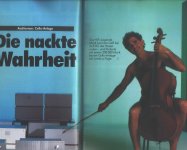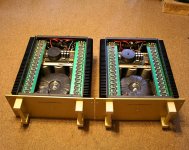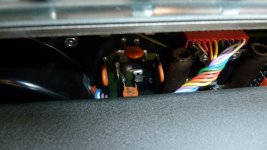then I'll be sole King of the Fools
Somebody has to play that role...
Attachments
Meu compatriota,
+ the 2SD600/2SD555 were exceptional TO3s for that time
Hi Jacco,
Just for the record:
In my samples the TO3 encased transistors are:
Drivers: 2SA1073/2SC2522 (or 23)
Powertransistors: MJ15023/MJ15022
Had to use a mirror to see them because they're upside down and my reading in mirror writing is not that good...
Maybe the Series I and II had the 2SD600/2SD555 transistors?
These ones:
Attachments
Last edited:
My bad, typo : 2SB600-2SD555
A case of the data-pollution i mentioned, couple of years ago someone started a thread about a pre-series Model 7, had the NEC devices : http://www.diyaudio.com/forums/solid-state/132589-rowland-research-amplifier-help.html#post1653492
Layout of your versions look as the ones i recall : http://www.diyaudio.com/forums/solid-state/132589-rowland-research-amplifier-help.html#post1651458
(Looks as you still have the black lunch boxes out though. One of the M7 series had the main transformer in a square shaped encapsulation, btw)
A case of the data-pollution i mentioned, couple of years ago someone started a thread about a pre-series Model 7, had the NEC devices : http://www.diyaudio.com/forums/solid-state/132589-rowland-research-amplifier-help.html#post1653492
Layout of your versions look as the ones i recall : http://www.diyaudio.com/forums/solid-state/132589-rowland-research-amplifier-help.html#post1651458
(Looks as you still have the black lunch boxes out though. One of the M7 series had the main transformer in a square shaped encapsulation, btw)
Last edited:
The pictures with the golden M7's were an example of an much earlier version that got maybe those NEC devices.
This is my Model 7 (Satin black finish):
It's the transimpedance version (Series IV) with the secondary powersupply for the frontendboard, DC detectioncircuit inside the left heatsink instead of on top of the sixpack.
I also supplied a picture from the Series II that had the maintransformer inside the lunchbox as you mentioned for the fisrt time.
Wait now I know what you ment with lunchboxes:
The encapsulated frontends, not the square enclosure of the toroid!
As far as I can remember Series I and maybe II also had no frontend encapsulated.
Mine has definitely and Series III also.
Maybe that's why I could supply a frontendschematic of the Series II because you could still see the parts.
This is my Model 7 (Satin black finish):
It's the transimpedance version (Series IV) with the secondary powersupply for the frontendboard, DC detectioncircuit inside the left heatsink instead of on top of the sixpack.
I also supplied a picture from the Series II that had the maintransformer inside the lunchbox as you mentioned for the fisrt time.
Wait now I know what you ment with lunchboxes:
The encapsulated frontends, not the square enclosure of the toroid!
As far as I can remember Series I and maybe II also had no frontend encapsulated.
Mine has definitely and Series III also.
Maybe that's why I could supply a frontendschematic of the Series II because you could still see the parts.
Attachments
Last edited:
The ones you have are absolutely gorgeous.
Though i still worship the ground Papa has treaded (and one fine day will steal either his slippers or jammies), i see what made you acquire these, love the hardwiring.
Front-end schematics of any of the M7 series would be grand for future accidental owners as Ungie, a shame to see amps of this stature end up as cases for amateur works.
Though i still worship the ground Papa has treaded (and one fine day will steal either his slippers or jammies), i see what made you acquire these, love the hardwiring.
Front-end schematics of any of the M7 series would be grand for future accidental owners as Ungie, a shame to see amps of this stature end up as cases for amateur works.
Last edited:
The one from Ungie looks like a pre-model 7 amp.
Kind of Jeff Rowland put the interiors of a WL-500 (West Lab 500 for the SoundLab A1 electrostatics) into a huge M7 chassis.
It had two 800VA transformers instead of one 2.4 kVA.
I'll ask Jeff myself if he can say it's a premodel 7 (pioneering device) or Series I.
I think the ones with the round toroids (not retangular cased are in fact Series I) I had a Series II in Slate Grey that already had the retangular cased version transformer.
Kind of Jeff Rowland put the interiors of a WL-500 (West Lab 500 for the SoundLab A1 electrostatics) into a huge M7 chassis.
It had two 800VA transformers instead of one 2.4 kVA.
I'll ask Jeff myself if he can say it's a premodel 7 (pioneering device) or Series I.
I think the ones with the round toroids (not retangular cased are in fact Series I) I had a Series II in Slate Grey that already had the retangular cased version transformer.
I am also interested by the question asked by Adwyun at the very beginning of this post, and that did not get an answer :
Would the SA/1 be "better" than the SA/6e or SA/10e in your opinion ?
Thanks for your reply !...
Is the answer biased [sorry!] in that the SA1s are monoblocks while the SA4e is stereo?
What about comparing the SA1 monoblocks with say the SA6e or SA10e monoblocks?
Would the SA/1 be "better" than the SA/6e or SA/10e in your opinion ?
Thanks for your reply !...
I am also interested by the question asked by Adwyun at the very beginning of this post, and that did not get an answer :
Would the SA/1 be "better" than the SA/6e or SA/10e in your opinion ?
Thanks for your reply !...
To be in line what Nelson Pass commented on this thread I deduce that the frontends are basically the same and all those amps differ only by the amount of parallel devices, their accompanying hardware and different railvoltage-settings
High railvoltage: 'S' class
Low railvoltage: 'SA' class
Pretty much the same with the PassLabs 'X' and 'XA' designations.
The SA/1 is a massive parallel circuit of the S/500 stereo-amp.
Same hardware in one mono-amp.
The SA/10e is a massive parallel circuit of the S/450 as I recollect and the SA/6e of the S/350 or SA/3.9.
To get the most hardware as Nelson stated you should go for the SA/10e
1.2 kVa, 196,000 uF and 44 outputdevices.
The SA/1 is of course the prettiest of them all with the VU meter!
It's one of the favorites of Jacco I believe.
Thanks for all !
For info, the SA/6e has a 800VA transformer (per channel), 28 transistors (per channel) and 250.000µF (total). It is supposed to deliver 50A (continuous) and 135A (peak).
I agree with you: the SA/1 is an attractive candidate with its beautiful "eyes"... (but supposed to deliver less current than the SA/6e).
For info, the SA/6e has a 800VA transformer (per channel), 28 transistors (per channel) and 250.000µF (total). It is supposed to deliver 50A (continuous) and 135A (peak).
I agree with you: the SA/1 is an attractive candidate with its beautiful "eyes"... (but supposed to deliver less current than the SA/6e).
Thanks for all !
For info, the SA/6e has a 800VA transformer (per channel), 28 transistors (per channel) and 250.000µF (total). It is supposed to deliver 50A (continuous) and 135A (peak).
I agree with you: the SA/1 is an attractive candidate with its beautiful "eyes"... (but supposed to deliver less current than the SA/6e).
According to the factory supplied specs the SA/1 should deliver 40 Amps contineous and 150 Amps peak.
Those amperage figures are theoretically values only to be reached at values around 0.1 Ohm.
When Audio (American magazin) tested the amp for 2 Ohm measurements it threatens to blow it's railfuses. So Nelson Pass supplied them with 2 Ohm powergraphs.
I conducted an experiment along the lines of Audio with mine SA/1's but did not stop until those fuses did blow.
I measured 39 Volts at a 2 Ohm load meaning almost 800 Watts at that load which I find superb for an amp at that age.
Audio (Now the German Magazine) confirmed in 1989 that the SA/1 delivers 40 Volts across 16, 8, 4 & 2 Ohm) so it posseses a stiff enough powersupply to drive my electrostatics.
With Threshold it pretty easy to assess what's the more powerfull amp or can be biased more:
Just count the coolingextrusions (you know those elements).
The SA/6 has three on every site, The SA/1 four and the SA/6 also 4 meaning that the SA/6 and SA/1 one have the same depth and therefore are more or less in same league. They can dissipate the same heat (I believe it's 40 Watts per heatsinkelement) and need the same hardware for it.
According to my Model 7 Certificate of Performance it is guaranteed to deliver 150 Amps at .1 Ohm for 20 milliseconds...
Wow! No kidding, those figures are not important at all though reviewers drool over them.
Last edited:
Front-end schematics of any of the M7 series would be grand for future accidental owners as Ungie, a shame to see amps of this stature end up as cases for amateur works.
I did supply the frontendschematic of the Series II a couple of pages back and asked Ungie some additional pictures of his M7 (he supplied to you already I believe) and if he ever restored his M7's completely.
I know you all do and I would love to keep my pair of SA/1's!Though i still worship the ground Papa has treaded (and one fine day will steal either his slippers or jammies), i see what made you acquire these, love the hardwiring.
Even better buy back my pair of Levinson ML-2's and Krell KMA-200 mk II's and in some miraculous way have a setup where the four can be switched from one to the other instantly and I would live happily and forever with the lot...
According to the factory supplied specs the SA/1 should deliver 40 Amps contineous and 150 Amps peak.
The brochure was clear that these figures hold for as long
as the fuses do, which is not long. The peak figure is the
absolute instantaneous peak. The 40 amp figure is a sine
wave with a nearly 60 amp peak, but it can only be
sustained for a large fraction of a second.
Both figures are aimed at people with large electrostatic
panels and similar.
😎
Threshold productliterature SA amps:The brochure was clear that these figures hold for as long
as the fuses do, which is not long. The peak figure is the
absolute instantaneous peak. The 40 amp figure is a sine
wave with a nearly 60 amp peak, but it can only be
sustained for a large fraction of a second.
Both figures are aimed at people with large electrostatic
panels and similar.
😎
"Permissible load:
Operation is allowed into any load within limits imposed by power supply and rail fusing and/or thermal protection."
When I read the Audio product review (January 1987) of the Threshold SA/1 I was a bit disappointed when it stated that:
"Although I did perform some measurements of power output at 2 Ohms, it soon became clear that if I tried to push the amplifier to its limits with that type of load, I would blow its fuses."
That's sounds to me like driving a Ferrari Enzo at the German Autobahn with a speedlimiter that kicks in at 125 mph.
That's why I performed those measurements myself and the SA/1 can still deliver 40 Volts at that load.
I have those large electrostatic panels and the SA/1's drive them beautifully.
Together with the JRDG Model 7 and the ML-2's I found them the best of all the amps I had in 25 years.
I've had bigger amps like the German Restek Exponents (spec'd at 1000 Watts) and McIntosh MC-2600 (2 x 600 Watts) that were not able to drive my Acoustats properly. I bet a pair of XA-160.5's will drive difficult speakers with ease because they can just like the SA/1's dump al lot of current and low loads. You won't need a Krell or Levinson to drive Acoustats or SoundLabs.
I have the possibility to choose from a pair of Jeff Rowland model 6 and a pair of Threshold SA-1 for bass ONLY duty. Bass system is comprised of 5 x Altec 515 Alnico 16 ohm, pr. side, in an open baffle/line source configuration.
Any thoughts on performance here? Preferences? these two amps should basically be in the same bracket as far as power is concerned.
Any thoughts on performance here? Preferences? these two amps should basically be in the same bracket as far as power is concerned.
these two amps should basically be in the same bracket as far as power is concerned.
But for everything else, they're not.
With power amps for bass use, stamina is more significant than power level.
The JRDG Model6 has the advantage of balanced operation, half the voltage on the rails translates to much higher output current levels per device.
Which doesn't make plastic the equivalent of twice as much metal.
The Model 6 uses 16 Toshiba 2SA1302/2SC3281 per channel (afair), 16 times 150W makes 2400W max dissipation.
Each SA/1 houses 40 TO3 power devices, 36 of which are the stable boys.
36 of the lowest Motorola TO3 grade handle 7200W dissipation, 3 times the Model6 number.
Secondly, The Toshiba devices cope a max temperature of 150C, Motorola TO3s are still alive at 200C.
Means that the Toshiba's dissipation derates 30% faster than the TO3s in the SA/1, when heatsink temperature goes up [(150-25)/(200-25)].
Thirdly, the heatsinks of the Model6 are pretty wimpy in comparison to the ones on the Threshold.
Cooling is of high importance for your intended use.
Fourth, iirc, the Model6 has 260,000uF capacitors per channel, the SA/1 has 120,000uF.
The Rowland amp is a balanced amp design : the rail voltages are much lower than normally required for 150W continuous power in 8, something like +/- 30Vdc.
Rail voltages of the Threshold are about twice as high.
For capacitance : Farad is Amps times second, per Volt.
Which means that energy wise, the capacitor bank in the Threshold contains twice the energy of the ones in the Rowland, despite being less than half the uF number.
Last edited:
so , I can conclude two things :
- Papa made wimpy amps from times of Twilight Zone
- Jaccollina have everything and knows everything , but is usually too lazy to type ..... and think
- sometimes - when some wimpy Papamp is in question , Jaccollina is willing to make unusual effort ......


( fact is that I'm lazy to count properly )
)
- Papa made wimpy amps from times of Twilight Zone
- Jaccollina have everything and knows everything , but is usually too lazy to type ..... and think
- sometimes - when some wimpy Papamp is in question , Jaccollina is willing to make unusual effort ......


( fact is that I'm lazy to count properly
 )
)Interesting tech-talk, Jacco, appreciate it. Longievity is of course interesting, these are "old" amps as such and bound to get some problems sooner or later.
The speakers represent an easy load, and with a sensitivity of somewhere between 103-105 dB (NOT when they are all operating in parallell) and NO eq whatsoever the average consumption during normal listening sessions should be in the 15-30W region. Right now, I am cruising along at 2-300mW with the occasional 5-6W showing on the peak hold meter (Accuphase A50V).
The main question is wether I will detect any significant differencies in the sound quality with either of the amps.
The speakers represent an easy load, and with a sensitivity of somewhere between 103-105 dB (NOT when they are all operating in parallell) and NO eq whatsoever the average consumption during normal listening sessions should be in the 15-30W region. Right now, I am cruising along at 2-300mW with the occasional 5-6W showing on the peak hold meter (Accuphase A50V).
The main question is wether I will detect any significant differencies in the sound quality with either of the amps.
keep one with which you are more emotionally bonded ;
then build any of FW amps and drive your lousy speakers with them
..... 5pcs 515s per side ...........
😱 🙄 😡 😱 😱

then build any of FW amps and drive your lousy speakers with them
..... 5pcs 515s per side ...........
😱 🙄 😡 😱 😱

- Status
- Not open for further replies.
- Home
- Amplifiers
- Pass Labs
- Threshold SA/4e vs SA/1




